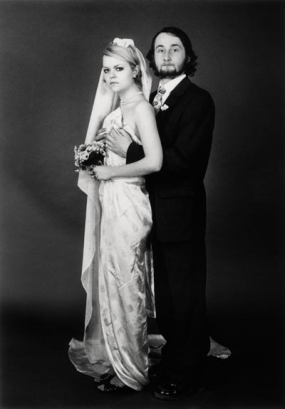| Revista Umělec 2003/1 >> Tomáš Bujňák | Lista de todas las ediciones | ||||||||||||
|
|||||||||||||
Tomáš BujňákRevista Umělec 2003/101.01.2003 Jiří Ptáček | new faces | en cs |
|||||||||||||
|
Born in 1979, Tomáš Bujňák, after attending several secondary art schools in Slovakia, was educated at the School of Fine Arts in Bratislava (20002001) then at FUTU in Košice (2001-2002), and last year he moved to Miloš Šejn’s studio of conceptual art at Prague’s AVU.
From the overview of art training, one might understand Tomáš Bujňák as being one of those hyperactive art jumpers. No joke: within several years he has experimented alternatively with every possible kind of expression. His paintings, sculptures, installations and environments often suffered variations in quality and whimsical superficiality. One past performance in Medzilaborce stands above them all for its physical input. Bujňák had the last word, “zivota” (life), of a convulsive inscription cut into his back with a glass shard. Another surprise was his pure technological-visual concept Transformacia do wordu (Transformation to Word). Bujňák subjected a reproduction of a medieval icon to changes in brightness and transferred it to a text editor. The result was the creation of a set of the letter x, concentrated into groups. During the gradual brightening of the reproduction, newly revealed spaces organized themselves as diagonal stripes. The machine found a code within this unusual task, one that could function secondarily as the discovery of the esthetics of a system. Despite any reservations, recently it seems that Bujňák’s talent has begun to fully express obscure metaphors of sexuality and violence. The photo-performance Svatba (Wedding) took place in a communal studio in cooperation with Lucie Dovičáková. The wedding party transformed the traditional wedding posturing into a yea-saying celebration of mutual sexual attraction. In the Internet project Slaaax with Ladislava Gážiová they introduced parallel possibilities in pornography, when it was transferred to short film loops of heads banging into each other. The interactive object Lavička (Bench) also plays with violence. This time it is unavoidably caused by anyone who gets up on his wobbly bench, which bounces around. The movement causes people on screens to drown, as they alternatively burst out in anger or plead for help. Equilibrium does not exist. Bujňák’s last creation is for the time being his most personal provocation, because it requires direct participation in a performance of apparent evil. Even this one is not without the humorous paraphrasing of the field, which, with the slightest hesitation, could slip into being embarrassingly macho. Only Tomáš Bujňák next work can sufficiently show how far his current view reaches.
01.01.2003
Artículos recomendados
|
|||||||||||||









Comentarios
Actualmente no hay comentariosAgregar nuevo comentario